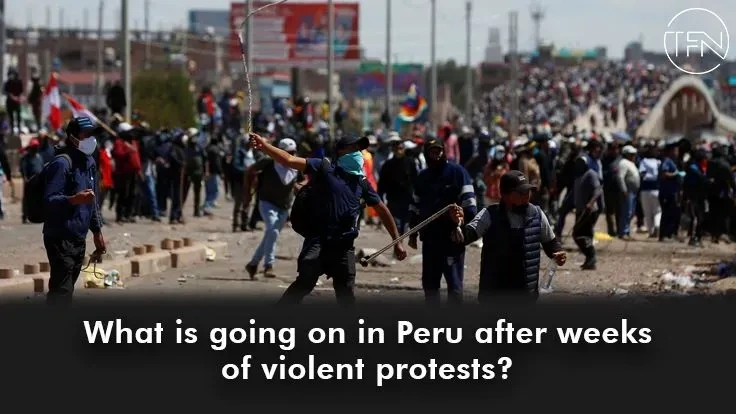
Thousands of protesters have gathered in Lima, the country's capital, to show their support for ousted president Pedro Castillo and demand the resignation of current president Dina Boluarte.
The massive rallies on Thursday are meant to keep pressure on the government in addition to calling for the dissolution of parliament and fresh elections.
These demands are being challenged by counter protests that are already taking place, a sign of the divisions dividing the country.
What led to the protests?
Since Castillo was fired by Congress on December 7 and replaced with his vice president, Boluarte, the country has been rocked by violent unrest.
After being accused of several charges of corruption, Castillo, 53, narrowly avoided two attempts by Peru's opposition-controlled legislature to have him removed from office. Before the third effort at impeachment on December 7, Castillo attempted to dissolve Congress and create a dictatorial administration. The constitutional court dubbed Castillo's remarks a "coup d'etat."
Peru's legislature and the governor had been at odds for years, and the house moved quickly to remove him. Boluarte was elected as Peru's sixth president in five years the following year.
Castillo is being held in pre-trial detention as he is being investigated for a potential uprising.
Why are there demonstrations today?
Many of the protesters are Castillo supporters and have a history with the outgoing president. They assert that since they are Indigenous and originate from secluded, mountainous regions of Peru, Boluarte cannot speak for them.
Beginning in the south, protests quickly spread to rural areas throughout the country.
43 people have died in conflicts with police over the five weeks of protests, according to Peru's human rights ombudsman.
Protesters claim that a government that has perpetrated such acts of cruelty against its citizens makes conversation impossible.
"We are Chota people from Cajamarca. Since we live in a dictatorship, we have come to Lima to defend our country. Our country has been stained by its blood "Corbin Herrera, a Cajamarca protester, said.
The massive demonstrations in Lima will call for Boluarte's resignation, the dissolution of parliament, and fresh elections.
"I'm furious. Angry. Luis Garro, another anti-government protester, is scared and worried by what is happening here.
He stated: "Dina Boluarte and the Congress, in my opinion, will be ousted by the people.
The vast bulk of the unplanned, grassroots protests has erupted over much of Peru during the last month.
According to analysts, Peru's long-standing, fundamental divisions have come to light as a result of the country's worst political violence in more than 20 years.
"The political environment in Peru is complex.” Professor of international affairs at the University of Oxford Alonso Gurmendi said that this issue cannot be reduced to a single event in 2023 or 2022 if you go a bit deeper into the structure of society.
People of Indigenous heritage have a long history of exclusion, and Indigenous people in Peru have been kept out of the economic expansion the country has seen.
According to him, if they cannot privatize their fundamental requirements, they are left alone every day. "Although GPD is expanding and the macroeconomic indicators are positive
"There is a paucity of public housing, high-quality healthcare, and enough support for public education.”
According to Gurmendi, the core of all of these protests is the divide between the area of Peru that can profit from the "economic miracle" and the area that cannot, which is still being left behind.
According to President Dina Bolouarte, who claims she is willing to engage with the protesters, they must assemble peacefully.
"We know that they intend to capture Lima because of all that is coming out on social media on the 18th and 19th of January," Boluarte stated in a speech on Tuesday.
She stated: "Since you are fully aware that the political agenda you are putting forward is unrealistic, I call them to capture Lima, but in calm and peace. I'll wait for you in the government building to discuss your social goals.”
Boluarte has said she is in favor of moving forward with the presidential and congressional elections from 2026 to 2024.
Hundreds of others participated in a "march for peace" in support of Boluarte on Thursday in Lima, protesting the protests by donning white T-shirts.
Although analysts contend that making forecasts is difficult, they do not see a brighter time ahead for the country.
Political expert Juan Claudio Lechin from Lima remarked, "It's extremely hard to predict what will happen."
The difference is that while the other half of the population is being aggressively mobilized, this half of the population is not being mobilized, so if Boluarte dares to stay, she can because she has the backing of the army, the police, and about 80% of the people.
Gurmendi asserts that the ruling political class has been unable to comprehend the reasons why Boluarte's supporters have called for his resignation.
The political class in Lima, according to Gurmendi, "is unable or unwilling to understand the core causes for the protests." They seem to believe that this was just an unlawful "terrorist attack" on the country.
"Unfortunately, I don't see this playing out in any fashion that is peaceful, not for some time," he concluded. “I think that a longer national discussion on how to change the system to incorporate everyone is necessary.”

